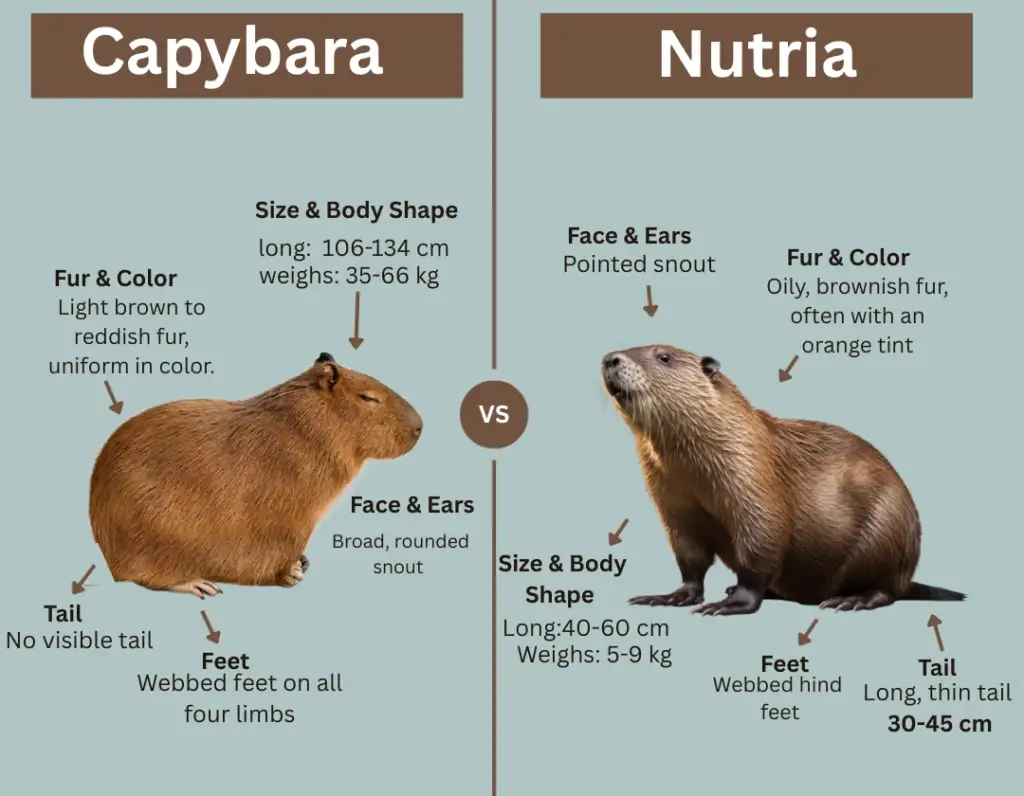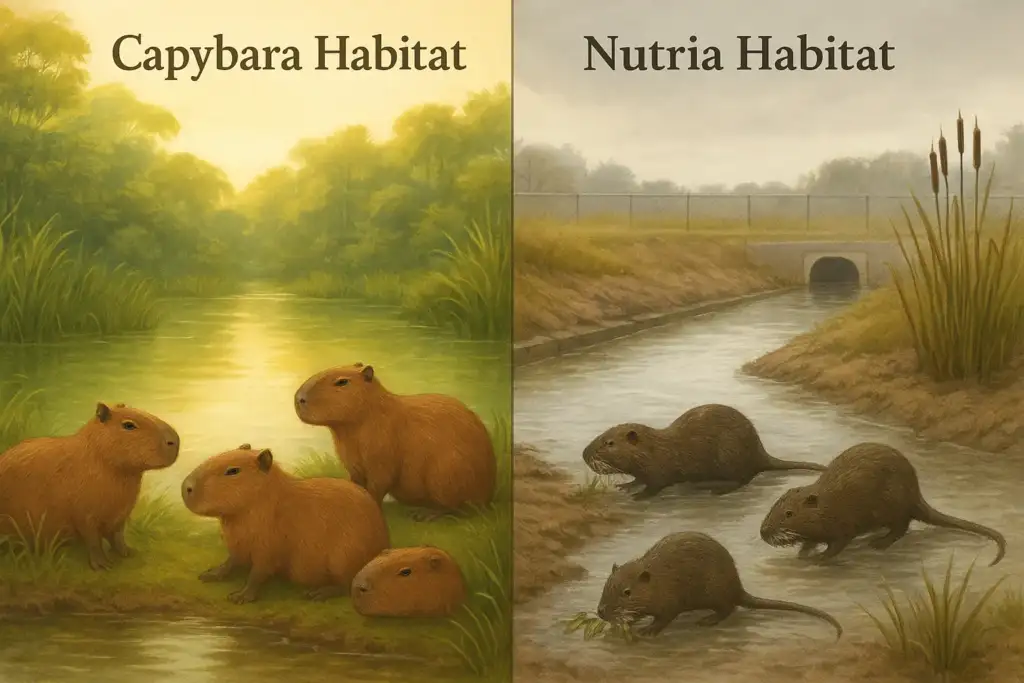Capybaras in California: Legal Truths, Invasion Risks, and Where to Spot Them
August 20, 2025Capybara Behavior and Why Are They So Chill: What I’ve Been Learning About the Internet’s Favourite Animal
August 22, 2025Capybara vs. Nutria: Unmasking the Differences Between Semi-Aquatic Mammals – A Detailed Guide
Have you ever seen a large, semi-aquatic rodent and wondered, “Is that a Capybara or a Nutria?”. Well, let me tell you one thing: you are not alone! These two fascinating creatures often get confused because of their remarkable similarities and appearances. But don’t worry, this guide will help you tell them apart confidently.
Decoding the Rodent Mystery: Introduction to Capybaras and Nutrias
Meet the Capybara: The World’s Largest Rodent
- Size and Status: Capybaras are also known as “the largest rodents on planet Earth.” They can weigh up to 150 pounds and measure over 4 feet long(about the size of a large Golden Retriever).
- Native Habitat: These giant rodents are native to South America. They primarily live near water resources, such as lakes and rivers. Wetlands, marshes, and riverbanks are ideal habitats.
- Personality: They are known for their calm and social nature. Capybaras live in large groups and even get along with other species like birds and turtles.
Meet the Nutria: The Adaptable Invader
- Size and Appearance: Nutria are smaller, weighing around 15-20 pounds. They have rat-like tails and webbed feet.
- Global presence: Nutria are also originally from South America but have become an invasive species in North America, Europe, and Asia due to their excellent adaptive qualities.
- Impact: Nutrias look harmless, but they are known for their destructive feeding habits, which can damage ecosystems and agriculture
Why the Mix-Up Happens:
At first glance, Capybaras and Nutrias share similarities: both are semi-aquatic, herbivores, and have brown fur, but once you know what to look for, you will be a pro at differentiating them.
Why You Should Keep Reading:
This guide will dive deep into their:
- Physical Traits (Size, tail, nose, and more)
- Habitats(native vs. invasive ranges)
- Diets(what they eat and how they feed)
- Behaviours (social structures and activity patterns)
- Ecological Roles(keystone species vs. invasive impacts)
Knowing the difference matters! For wildlife lovers, it enhances observation. For students, it’s a great enhancement in their biodiversity knowledge. And for anyone encountering these animals, it will help to appreciate their natural survival skills and unique behaviour.
Physical Showdown: Dissecting the Differences in Appearance

Capybara vs Nutria: Comparison Table
To make identifications easier, here’s a quick side-by-side comparison table of Capybaras and Nutrias. The table shows key differences in their size, tails, facial structures, and other physical traits so you can differentiate them at a glance.
| Feature | Capybara | Nutria |
| Size & Weight | 100–150 lbs (largest rodent) | 10–20 lbs (significantly smaller) |
| Body Shape | Stocky, barrel-shaped | Slender, rat-like |
| Fur | Coarse, reddish-brown to grayish-brown | Dense, brown, often oily |
| Tail | Vestigial (almost non-existent) | Long, round, scaly, rat-like |
| Nose/Snout | Broad, blunt, pig-like | Pointed, rat-like, with white whiskers |
| Ears | Small, rounded, high on the head | Smaller, positioned lower on the head |
| Feet | Slightly webbed, adapted for semi-aquatic life | Strongly webbed hind feet for swimming |
| Teeth | Large rodent incisors for grazing | Bright orange incisors, adapted for gnawing tough plants |
Now that you have seen the quick comparison between Nutria and Capybara. Let’s dive into the detailed comparison of each feature so that you can easily spot the difference between the wild.
Size & Weight:
- Capybaras: They are huge, typically weighing between 100 and 150 lbs. This large size supports the strong social structure and deters predators.
- Nutria: They are much smaller as compared to the capybaras and usually weigh around 15–20 lbs. A smaller body makes them more agile but also more vulnerable.
Body Shape and Build:
- Capybaras: They possess a strong, barrel-shaped body that gives them a bulky appearance.
- Nutria: They are more slender and rat-like, which makes them look quicker and leaner.
Fur Colour and Texture:
- Capybara: Have rough, brown-gray fur that dries fast.
- Nutria: Soft dark brown fur that looks a little oily.
Tail Shape and Length:
- Capybaras: They have tiny or no tails (like a stub).
- Nutria: Nutrias have long, round tails. Their tails are the same as rats’ (scaly and easy to see).
Nose and Snout Shape:
- Capybaras: They have blunt and wide noses, like a pig’s snout.
- Nutria: They have pointed and narrow noses, like a rat’s snout.
Ear Shape and Position:
- Capybaras: They have small and round ears, sitting high on their heads.
- Nutria: They have smaller and less visible ears on the side of their head.
Legs and Feet Adaptations:
- Capybaras: Their feet are bigger and little webbed (best for swimming and walking).
- Nutria: They have super webbed back feet (like duck feet) for fast swimming.
Teeth Structure:
- Capybaras: They have big and white front teeth for chewing grass.
- Nutria: They have orange front teeth (like rusty metal) for cutting through plants.
Habitat and Home Turf: Where Do They Roam?
Capybaras stick to South America’s wetlands, while Nutrias invade the globe. It’s necessary to ID them because confusing them risks missing the destructive Nutrias eroding riverbanks and crops.
Habitat Comaprison Table:
| Feature | Capybara | Nutria |
| Native Range | South America (Amazon, Orinoco, Gran Chaco) | Southern South America (Chile, Argentina) |
| Invasive Range | Mostly stays in South America | Global (North America, Europe, Asia, Africa) |
| Preferred Habitats | Grasslands, marshes, and riverbanks near water | Swamps, canals, urban ponds, and polluted water |
| Social Behavior | Highly social (groups of 10-30) | Solitary or small family groups |
| Ecological Impact | Keystone species (maintains ecosystems) | Invasive (destroys habitats, crops) |
Capybara Habitat and Geographic Distribution:

Native Range (South America):
- Key Regions: Capybaras are native to the Amazon Basin (Brazil, Peru), the Orinoco River (Venezuela), and the Gran Chaco (Argentina, Paraguay).
- Habitat Needs:
- Must have water: Grasslands, marshes, riverbanks.
- Social spaces: Capybaras require open areas for grazing in herds of 10-30.
Why They Stay Local:
- Capybaras stay because they are dependent on clean water and social groups.
- Capybaras are rarely invasive because they avoid polluted or human-dominated areas.
Nutria Habitat and Geographic Distribution:
Native Range (Southern South America):
- Nutrias are native to Chile and Argentina’s wetlands.
Invasive Global Spread:
Nutrias were brought to North America (1930s), Europe, and Asia for fur farming. Now, because of their invasive nature, they have spread to 30+ countries.
- Established Regions:
Nutrias has established the following regions so far:
- North America: Louisiana, Maryland.
- Europe: France, Italy.
- Asia: Japan, Korea.
Preferred Habitats (Even Outside Native Range):
- Adaptable: Nutrias are found worldwide because they can thrive in swamps, canals, polluted ponds, and urban water systems.
- Tough survivors: Nutrias are tough survivors because they can tolerate cold climates and dirty water better than capybaras.
Ecological Impact:
Nutria as an Invasive Species:
- Habitat destruction: Nutrias burrow into the land that collapses riverbanks, which can cause land erosion (e.g., Louisiana lost 10,000+ acres of marshland).
- Crop damage: Nutrias eat sugarcane, rice, and other crops.
- Competition: They compete with other native species like muskrats for food. (later, more info added)
Capybara as Keystone Species:
- Ecosystem role: Capybaras perform grazing that maintains healthy grasslands and wetlands.
- Prey species: Capybaras are food for many predators. So they support predators like jaguars, caimans, and anacondas.
Expert Tip: Use Habitat as a Clue
- Near a body of water in South America: You’re likely to see a capybara.
- Near water in North America, Europe, or Asia, you may have seen a nutria.
- But note: In parts of Argentina and Chile, invasive nutrias now overlap with native capybaras.
Dietary Habits: What’s on the Menu?
Nutrias and Caybaras are both herbivores, but their diets differ slightly depending on their habitat and physiological differences.
Capybaras Diet:
Capybaras are herbivorous grazers. Their primary diet includes grasses (80-90% of intake) and aquatic plants.
- Key Foods:
- Grasses: Pampas Grass, Bermuda grass.
- Aquatic Plants: Water hyacinth, Water lilies, Reeds.
- Occasional Snacks: Melons, squash, Grains (rare).
- Feeding Behaviour:
Capybaras graze on land and wade in shallow water. Capybaras are slow and selective eaters as they prefer tender shoots. They graze in herds for safety and share “watch duty” while eating.
Nutria Diet:
Nutrias are also violent herbivorous grazers mainly feeding upon aquatic plants, roots, and crops.
- Key Foods:
- Aquatic Plants: Cattails, bulrushes, duckweed.
- Crops: Rice, sugarcane, corn (major pest for farmers).
- Roots/Tubers: Dig up roots like sweet potatoes.
- Feeding Behaviour:
Nutrias have destructive foraging habits. They uproot entire plants, leaving only “eat-outs” (bare patches in marshes). They can also eat bark, snails, and small fish if starving. Nutrias swim to feed on floating plants and raid farmlands at night.
Diet Comparison Table:
| Feature | Capybara | Nutria |
| Diet Type | Specialist (grasses, aquatic plants) | Generalist (plants, crops, roots) |
| Main Foods | Pampas grass, water hyacinth | Cattails, rice, sugarcane |
| Feeding Style | Grazes selectively in groups | Uproots plants and eats destructively |
| Ecological Impact | Maintains grasslands | Destroys marshes, crops |
Key Differences Explained
- Selective vs. Destructive:
Capybaras carefully nibble grasses, leaving roots intact. On the other hand, Nutrias rip out entire plants, killing them and causing soil erosion.
- Social vs. Solitary:
Capybaras graze in herds for safety, while Nutrias often feed alone or in small groups.
- Farmers’ Friend vs. Foe:
Capybaras rarely damage crops. Nutrias eat everything, costing farmers millions yearly (e.g., $3M/year in Louisiana rice fields).
Dietary Overlap & Competition:
Both Capybaras and Nutrias feed on aquatic plants like reeds and cattails. In South America, invasive nutrias may compete with capybaras for aquatic plants. Competition between them is rare because capybaras tend to avoid polluted/nutria-infested areas, which reduces the direct competition.
Apart from the diet, there are many behavioural differences among them. Capybaras live in social squads, while nutrias are lonely survivors. Let’s dive into their behaviour next!
Behaviour and Social Life: Understanding Their Lifestyles
Capybara Behaviour:
Capybaras are mostly seen in groups of 10-20 individuals (up to 100 in dry seasons). The group is led by a dominant male and female, and subordinates follow strict rules (e.g., eating last).
- Cooperative Behaviours:
- Grooming: Capybaras clean each other to bond and remove parasites.
- Vigilance: Herd members take turns to look out while grazing
- Pup parenting: Female capybaras nurse each other babies.
- Activity Patterns:
- Diurnal/Crepuscular: Most active at dawn/dusk.
- Water Time: Spend 4-6 hours/day in water to cool off and avoid predators (jaguars, anacondas).
- Vocalisations (Expert Tip):
- Sounds: Barks (alarm), whistles (group coordination), purrs (contentment).
- Audio Suggestion: Link to Capybara purring sounds for reference.
Nutria Behaviour:
Nutrias typically live solitary lives or form small groups of 2-5 members. Unlike capybaras, they don’t follow a strict social hierarchy. Nutria groups are temporary, often coming together only around food or water resources.
- Activity Patterns:
- Nocturnal/Crepuscular: Active at night to avoid humans.
- Water Dependency: Swim 100+ meters daily, using webbed feet to forage.
- Vocalisations (Expert Tip):
Nutrias are quieter because they communicate using body language and scent marking. Unlike capybaras, they don’t have strong social bonds that require frequent interactions.
- Sounds: Hisses (warning), grunts (aggression), squeaks (communication).
- Audio Suggestion: Link to Nutria hissing sounds.
Behavioural Comparison Table:
| Trait | Capybara | Nutria |
| Social Structure | Large, hierarchical herds | Solitary or small, unstable groups |
| Activity Time | Daytime (dawn/dusk) | Nighttime |
| Swimming Style | Slow, relaxed floats | Fast, agile paddling with webbed hind feet |
| Vocalization | Complex (barks, purrs) | Simple (hisses, grunts) |
Key Differences Explained
- Social Butterflies vs. Lone Rangers:
As mentioned earlier, Capybaras rely on herds for survival, and nutrias thrive alone.
- Day vs. Night:
Capybaras are active during the daytime, and on the other hand, Nutrias only come out during the night.
- Communication:
Capybaras “talk” constantly, and Nutrias stay quiet unless they are threatened.
Expert Tips for Identification:
- Look for Groups: If you see 10+ rodents together, it’s capybaras.
- Listen at Night: Hissing or grunting? Likely a nutria.
- Check Swim Style: Slow, floating = capybara; fast, diving = nutria.
Which is the True Water King?
Capybara uses water for relaxation and safety (think: spa days), while on the other hand, nutria uses water for survival and travel (think: Olympic swimmer).
Ecology and Environmental Impact: Roles and Ripple Effects
Both Capybara and Nutria have developed behaviours that support their lives and survival. Capybaras protect ecosystems, while nutrias destroy them. Let’s see how their behaviours have impacted our environment.
Capybara: The Ecosystem Guardian
Capybaras aren’t just the world’s largest rodent–they play a crucial role in maintaining the balance of their ecosystem. The following are the keystone-specific roles that are necessary for the beauty of nature and the food chain:
Grazing Engineers:
The constant grazing prevents the grassland from becoming overgrown. It helps to maintain the biodiversity of the ecosystem.
Example: In the Pantanal wetlands, they create “lawns” that attract birds, insects, and other herbivores.
Prey Powerhouse:
Capybaras act as a critical food source that supports apex predators like:
- Jaguars (30% of a jaguar’s diet in some regions).
- Caimans and anacondas (especially juveniles)
Seed Dispersal (Debated):
Capybaras’ movement spreads some aquatic plant seeds via fur and faeces. We can’t mark them as primary seed dispersers.
Why They Matter:
Capybaras play a significant role in maintaining their native environment. Lose capybaras, and entire food webs collapse–grasslands turn into thickets, predators starve, and biodiversity crashes.
Nutria: The Invasive Wrecking Ball
Unlike the ecosystem-friendly capybara, the nutria is a destructive force when introduced outside its native range. The following are the reasons that make them villains of the environment they invade:
Eat-Outs:
Nutria’s destructive feeding uproots 90% of marsh plants in invaded areas. These kinds of poor feeding habits turn wetlands into barren mudflats.
- Example: Louisiana lost 100,000+ acres of marshland to nutrias since 2000.
Burrow Damage:
Nutrias dig extensive burrows along riverbanks, levees, and irrigation systems that weaken the soil. Over time, these tunnels can collapse, leading to erosion, flooding, and costly damage to infrastructure.
- Cost: $10M+ annually in U.S. repairs.
Agricultural Damage:
Nutrias feed on rice, sugarcane, and corn. It causes significant losses for farmers and impacts local agriculture.
- Example: Maryland farmers report 30-50% crop loss in nutria-infested fields.
Competition:
Nutrias take over the food and burrowing spots of native animals like muskrats, forcing them to move out. They also destroy plants that are required by endangered turtles and birds for nesting, leaving them nowhere to go.
Convergent Evolution: Nature’s Copycats
Despite evolving separately for over 40 million years, capybaras and nutrias have developed strikingly similar adaptations to thrive in wetlands. They both have webbed feet for swimming and water-resistant fur.
The evolutionary roots of capybara and nutrias are different–capybaras are true rodents, and nutrias are more related to porcupines. Their diet also shows their unique paths; capybaras are natural grazers while nutrias dig and uproot plants.
Why It’s Fascinating:
This parallel evolution shows how nature often finds similar solutions to survival. Nutrias are close to capybaras as they have developed some common solutions to thrive in wetlands.
Ecological Impact Comparison Table
| Role | Capybara | Nutria |
| Habitat Impact | ✅ Maintains grasslands and wetlands | ❌ Destroys marshes, collapses riverbanks |
| Food Web Role | ✅ Prey for 10+ predator species | ❌ Competes with 5+ native species |
| Economic Impact | ✅ Boosts ecotourism (e.g., Pantanal safaris) | ❌ Costs $50M+/year in U.S. damage |
Expert Tips for Readers:
- Spot the Damage: Bare marsh patches + chewed crops = nutria presence.
- Support Conservation: Report nutria sightings to local wildlife agencies.
- Travel Responsibly: Visit capybara habitats (e.g., Brazil’s Pantanal) to support eco-friendly tourism.
Are Capybara and Nutria the Same?: Conclusion
Capybaras and nutrias look similar at first sight, but they are different in their behavior, habitat, and diet, e.t.c. Here are some major key differences that you can use to recognise them at first glance.
Key Differences at a Glance
| Feature | Capybara | Nutria |
| Tail | No tail (tiny stub) | Long, rat-like, scaly tail |
| Nose | Blunt, pig-like snout | Pointed, rat-like snout |
| Size | 100-150 lbs (size of a large dog) | 10-20 lbs (size of a house cat) |
| Habitat | South America only | Global invader (avoid if outside SA) |
Why Observation + Context Matter
- Double-Check Clues:
- See a long tail? Think nutria. No tail? Capybara.
- Spot orange teeth? Nutria. White teeth? Capybara.
- Location Matters:
- South America near water? Likely a capybara.
- North America/Europe/Asia? 99% nutria.
Keep Learning!
- Explore Further:
- Track capybaras: IUCN Red List.
- Report nutria sightings: USDA Wildlife Services.
- Field Guides:
